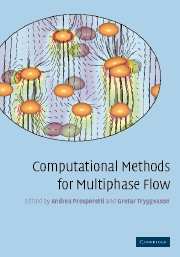Book contents
- Frontmatter
- Contents
- Preface
- Acknowledgments
- 1 Introduction: A computational approach to multiphase flow
- 2 Direct numerical simulations of finite Reynolds number flows
- 3 Immersed boundary methods for fluid interfaces
- 4 Structured grid methods for solid particles
- 5 Finite element methods for particulate flows
- 6 Lattice Boltzmann models for multiphase flows
- 7 Boundary integral methods for Stokes flows
- 8 Averaged equations for multiphase flow
- 9 Point-particle methods for disperse flows
- 10 Segregated methods for two-fluid models
- 11 Coupled methods for multifluid models
- References
- Index
11 - Coupled methods for multifluid models
Published online by Cambridge University Press: 07 December 2009
- Frontmatter
- Contents
- Preface
- Acknowledgments
- 1 Introduction: A computational approach to multiphase flow
- 2 Direct numerical simulations of finite Reynolds number flows
- 3 Immersed boundary methods for fluid interfaces
- 4 Structured grid methods for solid particles
- 5 Finite element methods for particulate flows
- 6 Lattice Boltzmann models for multiphase flows
- 7 Boundary integral methods for Stokes flows
- 8 Averaged equations for multiphase flow
- 9 Point-particle methods for disperse flows
- 10 Segregated methods for two-fluid models
- 11 Coupled methods for multifluid models
- References
- Index
Summary
In the previous chapter we have presented segregated solution methods for multifluid models. When the interaction among the phases is very strong, or the processes to be simulated have short time scales, the methods that we now describe, in which the equations are more tightly coupled in the solution procedure, are preferable.
Work on methods of this type received a strong impulse with the development of nuclear reactor thermohydraulic safety codes in the 1970s and 1980s. This activity led to well-known codes such as RELAP, TRAC, SIMMER, and several others. The latest developments of these codes focus on the refinement of models, the inclusion of three-dimensional capabilities, better data structure, and vectorization, rather than fundamental changes in the basic algorithms. By and large, the numerical methods they employ are an outgrowth of the ICE approach (Implicit Continuous Eulerian) developed by Harlow and Amsden (1971) in the late 1960s. While very robust and stable, these methods, described in Section 11.2, are only first-order accurate in space and time and have other shortcomings. The more recent work, some of which is outlined in the second part of this chapter, is based on newer developments in computational fluid dynamics which are summarized in Section 11.3.
A tendency toward more strongly coupled solution methods is also evident in contemporary work springing from the segregated approach described in the previous chapter (see, e.g. Kunz et al., 1998, 1999, 2000). These developments lead to a gradual blurring of the distinction between the two approaches.
- Type
- Chapter
- Information
- Computational Methods for Multiphase Flow , pp. 386 - 435Publisher: Cambridge University PressPrint publication year: 2007

